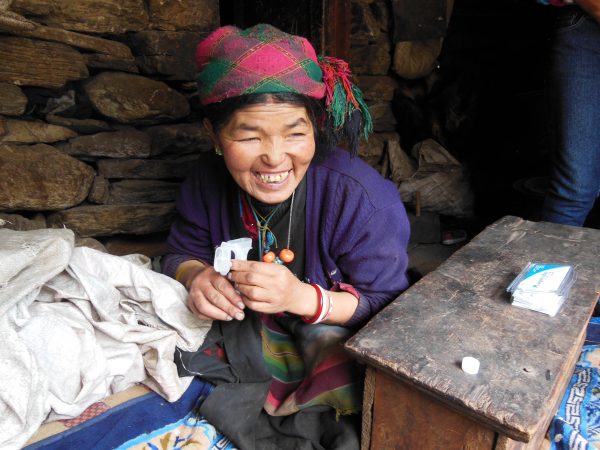Over thousands of years people in highland regions across the world have adapted to extreme environments that are seemingly hostile to human survival. The work of Cynthia Beall, Distinguished University Professor and Sarah Dell Pyle Professor of Anthropology, combines interdisciplinary approaches to explore how populations have adapted to environmental stress in high altitudes with far-reaching impacts on our understanding of natural selection, human biology, and human health.
Hypoxia at High Altitudes
At high elevations (more than 2500 meters), a reduction in air pressure results in fewer molecules of air in a given volume (such as a breath), including fewer oxygen molecules. This causes environmental hypoxia (less than the normal amount of oxygen) to become physiological hypoxia. People accustomed to low altitudes and acutely exposed to high-altitude hypoxia increase the concentration of hemoglobin, the oxygen-carrying molecule, which in turn increases the amount of oxygen carried and offsets the environmental hypoxia.
For populations who call high altitudes home, adaptions to this stress are varied, perplexing anthropology and biology researchers alike. While Andean highland populations respond the same way as lowlanders, with elevated hemoglobin concentration, Tibetan populations have evolved a much different, and seemingly perplexing, adaption.
Instead of elevated hemoglobin, which can ultimately cause stress on the cardiovascular system, Tibetan populations’ respond through their respiratory and vascular systems. A brisk hypoxic ventilatory response means that the Tibetans studied increase their oxygen intake with high ventilation and increased oxygen delivery with fast blood flow.

The Research + Findings
With support from the National Science Foundation, Dr. Beall and her team traveled to the highlands of northern Nepal to better understand the evolutionary process behind this adaption. This work combined cultural, biologic and genetic information to measure and their association with women’s fertility, the classic measure of Darwinian fitness.
Structured interviews collected information on sociocultural factors influencing fertility, such as wealth and marital status. “We know that it is more than your genes that determine how many pregnancies you have,” Dr. Beall shared.
Non-invasive measurements of hemoglobin concentration and oxygen saturation of hemoglobin, and saliva samples for DNA genotyping were collected from 1,006 Tibetan women. This approach connecting the extreme stressor of high-altitude hypoxia, to genetic variation, biological variation, and reproductive outcomes was used to test whether Tibetan’s unique adaptation reflects the results of natural selection.
Natural Selection at Work

For natural selection to be at work, a heritable variation must be at play. With the help of genomic studies, Dr. Beall’s team found just that. Previous studies identified virtually unique forms of a gene called EPAS1 that is known to influence hemoglobin concentration. The particular variant found in high frequencies (70% or higher) among Tibetans occurs at extremely low frequencies in the rest of the world’s population.
The ‘Tibetan’ variant at EPAS1 associated with unelevated hemoglobin concentration. Unelevated hemoglobin concentrated correlated with better reproductive success. However, EPAS1 on its own did not associate with higher reproductive success as hypothesized. This discrepancy may be because EPAS1 is a transcription factor, which turns on many genes and influences many traits in addition to those involved.
This study, Dr. Beall concluded, illustrates a great strength of anthropology: the ability to better understand how biology, culture and our environments influence one another.
Broader Implications
By being able to connect unelevated hemoglobin concentration in Tibetan women, an inherited trait, to higher fertility success, these findings are evidence of natural selection at work. Taken together with anthropological investigations in the Andes, these independent experiments in microevolution illustrate how populations have adapted to high altitude stresses in very different ways.
Extending beyond evolutionary anthropology, this work is changing our understanding of the nature of human biology by showing that Andean and Tibetan highlanders adapt differently to the same stress. This tells scientists and physicians caring for hypoxic patients at any altitude, that more than one healthy response is possible.
Going a step further, evidence from randomized clinical trials in hospitals at low altitude show that hypoxia can be a defense against some diseases rather than simply manifesting as a disease-related defect or pathology. This new knowledge opens new doors for evolutionary medicine and healthcare providers to understand how to treat patients suffering from diseases associated with hypoxia.

Learn more about the work of Cynthia Beall and this work at the Genes and Fertility Website.
